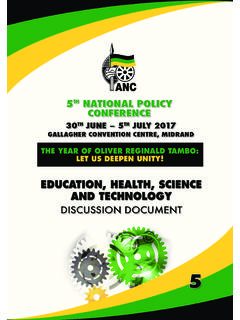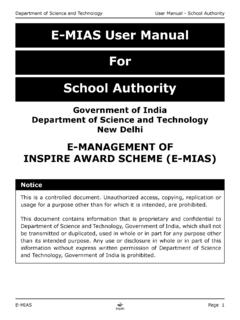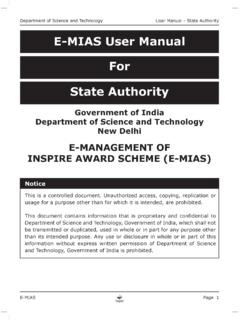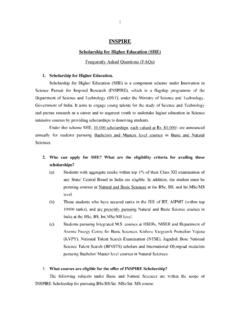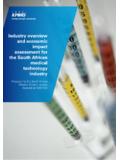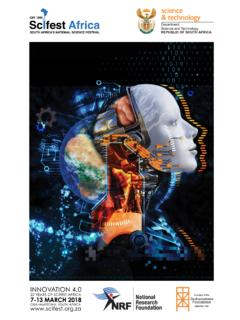Transcription of SOUTH AFRICA - OECD
1 SCIENCE AND innovation : SOUTH AFRICA . SOUTH AFRICA . Hot STI issues Strengthening innovation capacity in the business and public sector to boost economic performance and address social challenges. Fostering collaboration between government, academia and business. Improving the governance of the innovation system. General features of the STI system: SOUTH AFRICA is fixed broadband subscribers number about the continent's leading economy, with strong 1 per 100 inhabitants (1(k)) although there is a fast- resource-based industries and strengths in growing mobile telephony market throughout all of services. Its innovation system has been shaped by society. The development of network industries has infrastructure, assets and distortions inherited been hampered by market domination by state- from the apartheid era. In 2008, BERD was of owned firms and restrictive legislation.
2 GDP but 59% of GERD. While a large resource-based Recent changes in STI expenditures: Recent growth in sector and the secondary economy limit the level GERD has been driven by public money, injected and leverage of business R&D investments, the S&T. since 2002 as part of the National R&D Strategy. base supports pockets of global excellence. Between 2003 and 2008, business funding of R&D. Research and innovation rely on industry-science hardly increased while government funding links (Panel 1(o)) and there is good integration in doubled (Panel 2). Public funding is expected international business and academic networks. to keep increasing owing to the government's International collaboration plays a role in 46% of competitiveness and growth package. SOUTH scientific articles and 14% of patents (1(q)(r)). SOUTH AFRICA attracts R&D funding from abroad from AFRICA 's RTA in emerging technologies increased multinational companies and through its rapidly over the past decade, albeit from a low base, active participation in global R&D initiatives notably in biotechnology.
3 RTA in environmental (EU Framework Programmes) as well as through technologies has eroded, however. A major joint R&D programmes with multinationals. bottleneck for SOUTH AFRICA 's economic and social d eve l o p m e n t i s t h e l a c k o f a b r o a d s k i l l s Overall STI strategy: The Ten-Year innovation Plan foundation. Only 4% of the adult population has (2008-18) identified five grand challenges : tertiary level education (1(s)); 16% of workers are in biotechnology and pharmaceuticals, space, energy S&T occupations (1 ( v ) ). The lack of design, security, climate change, and understanding of social engineering, entrepreneurial and management dynamics. These are in line with SOUTH AFRICA 's capacity is a major constraint. The ageing of the technological advantages, dependency on coal and w h i te m a le p o p u la t io n of re s e a rch e r s a nd social challenges.
4 Growing attention is given to engineers further weakens the skills base. IT allocation of public resources to address gaps in infrastructures are relatively under-developed: human capital and infrastructure in these areas. Key figures Labour productivity, GDP per hour worked in USD, 2010 GERD, as % of GDP, 2008 (annual growth rate, 2005-10 ) (annual growth rate, 2005-08) (+ ). Environmental productivity, GDP per unit of CO2 emitted in USD, 2009 GERD publicly financed, as % of GDP, 2008 (annual growth rate, 2005-09) (+ ) (annual growth rate, 2005-08) (+ ). 380 OECD SCIENCE, technology AND INDUSTRY OUTLOOK 2012 OECD 2012. Fi xe d W br oa ir e db le an Pu OECD. OECD. OECD. OECD. Ne ss bl tw d ic Top half Top half br su Pu Bottom half Bottom half or oa sc bl R&. ks db r ib ic at D. (a an io ex ut on d er s( ns To p pe su in 50 nd pe 0. 50. 100. 150. 200. 0.))
5 50. 100. 150. 200. om sc ou r ib rp th 0 i tu re er op et un ss s( ul op iv (p ys at -q er er te pe io ua si GD. E- m rp n) r ti tie P). go s) op (k le s(. (p ) jo pe (a ve rn er ul at ur rG ). m po io na DP. en pu n) ls In (l) )(. tr la (p b). du ea t io er st di n) GD. ry ne (m P). Pa -f i ss ). Science base na in (c te nt nc de ). sf ed x( Bu il e pu n) To sin Internet for innovation d bl p es by ic 50 sR. un R& 0 &D. iv D co er ex rp ex si or Top/bottom 5 OECD values tie pe at pe sa nd eR nd nd i tu &D i tu In re Tr re te pu s( ia in (p rn bl pe di ve er ic OECD SCIENCE, technology AND INDUSTRY OUTLOOK 2012 OECD 2012. at rG cp st GD. io la at or P). na bs DP en s(. In lc (p )( pe (d te o- er o) tf ). rn au am rG. at GD ili DP. io th Tr es na or P). (p a de (p )(. lc sh e). o- ip ) m er pa (% ar GD. te ks P). Ad nt )( (p ul in q) er (f ). tp g GD. a.
6 Competences and capacity to innovate op (% P). commercialisation ul )( (g at r). Knowledge flows and io ). n b. Interactions and human resources for innovation Do 15. - Pa Business R&D and innovation ct at Middle range of OECD values or ye te te al ar r ti nt gr -o ar in ad ld ye g to f ir Ve ua t io p du m nt pe ca sl ur S& n r fo tio es ec ra rm n T te le st ha ap oc in er ve n ita Panel 1. Comparative performance of national science and innovation systems, 2011. cu 5 l(. Figure Science and innovation in SOUTH AFRICA sc si l(. pa ie n % Ea se ye pe t io nc sc )( ar rG. ie of Note: Normalised index of performance relative to the median values in the OECD area (Index median = 100). ns ea nc s) so DP. in nd e( en ld )(. to en % tr e (p h). OECD median ta gi )( pr er le ne t) en GD. m er eu P). pl in rs oy g hi p (i). m (u in en ) de t(. % x(. Human resources )( j).
7 Entrepreneurship v). SOUTH AFRICA SCIENCE AND innovation : SOUTH AFRICA . 381. SCIENCE AND innovation : SOUTH AFRICA . STI policy governance: The OECD Reviews of technology Transfer Centre provides grants for innovation Policy: SOUTH AFRICA pointed to scope for technology transfer to the secondary economy. The improvement, including in horizontal and vertical technology Localisation Programme provides non- policy co-ordination. The Ministry of Science and financial assistance to local manufacturers to help technology (DST) has tasked a committee to them qualify for public procurement programmes, evaluate the functioning of the national system of while technology stations provide innovation innovation . m a n a g e m e n t a n d s u p p o r t f o r t e ch n i c a l Business R&D and innovation : SOUTH AFRICA intends development to inventors, entrepreneurs and SMEs.
8 T o a d d c a p a c i t y f o r d eve l o p i n g a dv a n c e d Human resources: To nurture a new generation of manufacturing technologies and new R&D-led researchers and to address skills shortages, a series industries in order to transform the industrial base, of initiatives aim to encourage participation in e n h an c e l oc a l a p p ro p r ia t i o n, b e ne f i t f ro m STEM studies ( Youth into Science Strategy), in natural resource endowments and increase doctoral and postdoctoral studies (National competitiveness. The Framework for SOUTH AFRICA 's Research Foundation Fellowships) and in research Response to the International Economic Crisis (2009) careers, including for women and the black reiterated a growing need for scientific and community ( Thuthuka Programme). Financial technological input to address national challenges support to researchers has helped to mitigate brain in areas such as energy security, food security and drain.
9 The new National Human Resources industrial development. Subsequently, increased Development Strategy (2010-20) anticipates future financial support to industry was announced to national human resources requirements. Increased drive the National Industrial Policy Framework policy attention has been paid to lifelong learning (NIPF), which had been adopted before 2008. Links to and better articulation between workplace learning STI policies are to be strengthened with the creation and higher education. of the technology innovation Agency (TIA) (2010). Emerging technologies: The Biosciences Park is being ICT and scientific infrastructures: SOUTH AFRICA has developed to assist biotechnology start-up firms to made structural investments in larg e-scale incubate marketable products. An Astronomy Desk facilities. Based on its ICT Strategy, infrastructure has been established at the DST and the SOUTH projects have been rolled out, the Centre for African National Space Ag ency has been High Performance Computing and the SOUTH established.
10 African National Research Network (SANReN), a Green innovation : Development of the renewables high-speed network that connects the SOUTH market is seen as key to energy sufficiency and the African research community to global research transition to a green economy. The SOUTH African networks. Significant investments in scientific Renewables Initiative (SARi) foresees an ambitious equipment include the Centre for High Resolution 25% reduction in CO2 emissions. The Renewable Electron Microscopy (CHRTEM) and the world-class Energy Finance and Subsidy Office (REFSO) was set Karoo Array Telescope (MeerKAT). The National up to manage renewable energy subsidies and Roadmap on Research Infrastructure is currently offers advice to developers. The Green Efficiency being developed. Fund, which is administered by the Industrial Knowledge flows and commercialisation: Adoption of Development Corporation (IDC), assists SOUTH IP policies for publicly funded R&D, the creation of African companies to invest in energy efficiency the National Intellectual Property Management and renewable energy projects.










